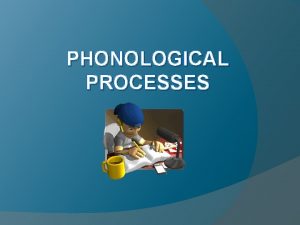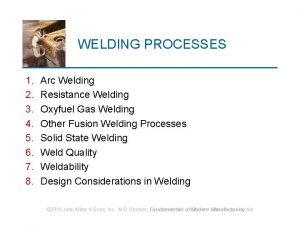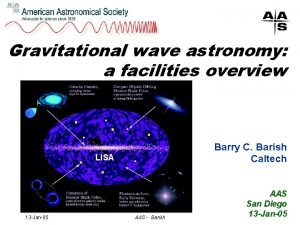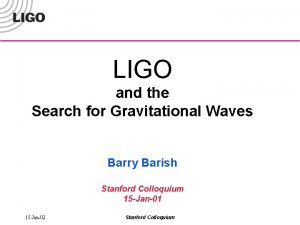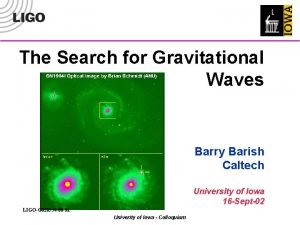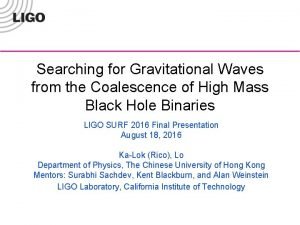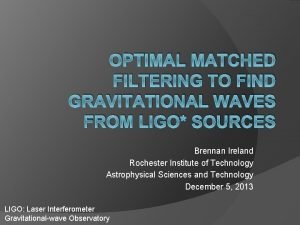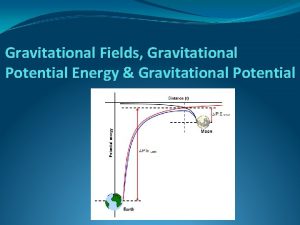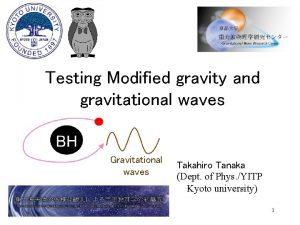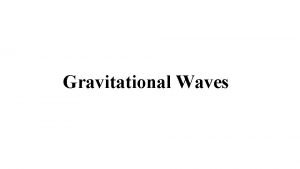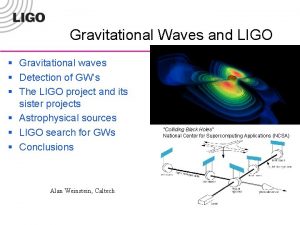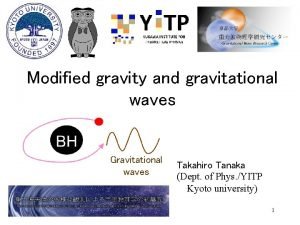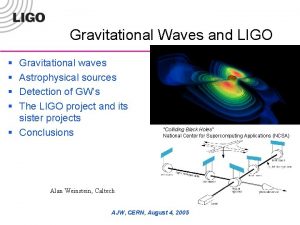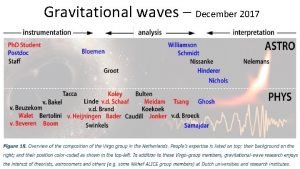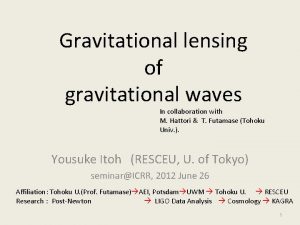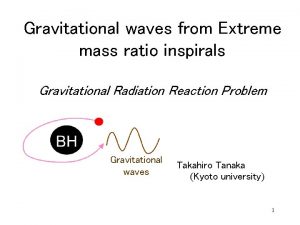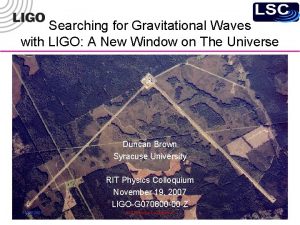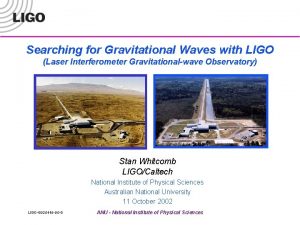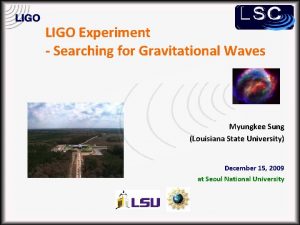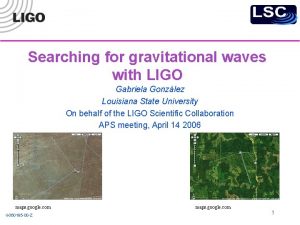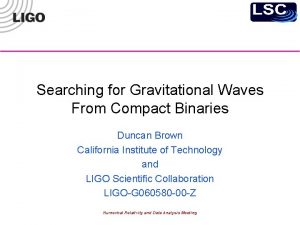Searching for Gravitational Waves from the Coalescence of
































![Reference l l [1]: The LIGO Scientific Collaboration, the Virgo Collaboration, B. P. Abbott, Reference l l [1]: The LIGO Scientific Collaboration, the Virgo Collaboration, B. P. Abbott,](https://slidetodoc.com/presentation_image/2710b01fbb01f993afe34418a555564f/image-33.jpg)























- Slides: 56

Searching for Gravitational Waves from the Coalescence of High Mass Black Hole Binaries LIGO SURF 2016 Final Presentation August 18, 2016 Ka-Lok (Rico), Lo Department of Physics, The Chinese University of Hong Kong Mentors: Surabhi Sachdev, Kent Blackburn, and Alan Weinstein LIGO Laboratory, California Institute of Technology

Overview l l l l Introduction Tuning Search Parameter: fmin h(t) Gating Other Projects Acknowledgement Reference Q&A LIGO Scientific Collaboration 2

Introduction 1. Background • • • 2. Searching for Gravitational Waves Matched Filtering gstlal: the search pipeline Objectives of the research project LIGO Scientific Collaboration 3

Searching for Gravitational Waves l l Amplitude of GW is small (10 -21 to 10 -28) Even worse, the detector is noisy Impossible to detect one by naked eye Need a more reliable and systematic way to search for GWs (proper data analysis) Band-passed h(t) Best-matching template LIGO Scientific Collaboration Figure taken from [1] 4

Matched Filtering l l A powerful technique to search for a signal from a noisy data if we know what we are looking for Procedures: 1. Figure out the expected waveforms (a lot of physics!) 2. Generate many of those expected waveforms (templates), forming a template bank 3. Slide a template across the signal and compare the ‘similarity’ 4. Find peak of the matched filter responses 5. Repeat Step 3 and 4 for all the templates in the bank 6. Find coincident triggers (found in both H 1 and L 1) l Template bank defines the parameter space (masses and spins) covered by a search LIGO Scientific Collaboration 5

Matched Filtering: Definition of SNR l l l Q: How can one quantify the similarity between the template and signal? A: Compute the Signal-to-Noise Ratio (SNR) Suppose we are filtering the data with some normalized templates Matched filtering response to Power Spectral Density of Noise LIGO Scientific Collaboration 6

gstlal: the search pipeline l l l Low Latency (on-line) search pipeline for compact binary coalescences (CBC) EM Follow-up made possible (e. g. X ray, Visible light, Radio wave emitted from BNS merger) Average latency ~ 1 minute (median latency) Can be operated in either on-line or off-line mode Based on matched filtering and detector network coincidence LIGO Scientific Collaboration 7

Parameter Space Covered by gstlal (uberbank) l Currently l Assumed component spins aligned with orbital angular momentum (no precession) LIGO Scientific Collaboration Figure taken from [3] 8

Objectives of this project l l In short: optimizing the search More specific: Expanding the parameter space to cover Intermediate Mass Black Hole (IMBH) region l But there a lot more to consider LIGO Scientific Collaboration 9

What can possibly go wrong? l For instance: 1. 2. 3. 4. l Change in sensitivity for different astrophysical sources Change in performance and extra computational costs (important for real-time GW detections) Ensuring high mass templates are sensible Compatibility of existing codes We want (or try) to answer them! LIGO Scientific Collaboration 10

Tuning Search Parameter: fmin 1. 2. Motivation: Why do we need to tune fmin? Results • 20 Hz vs. 30 Hz • 15 Hz vs. 20 Hz LIGO Scientific Collaboration 11

Observing GW Signals from IMBH l Higher the mass of the binary system, lower the ringdown frequency l is the total mass and is the reduced Kerr spin parameter For a binary system with and , the ring-down frequency is approximately 19. 8 Hz l LIGO Scientific Collaboration 12

Observing GW Signals from IMBH l Lower the starting frequency in order to observe them » Uberbank: 30 Hz » IMBH: 15 Hz l l IMBH search was separated from the uberbank search and done off-line Challenge: Combining the IMBH bank with the uberbank for on-line detection » So we may detect more signals during on-line search l l Q: Should we lower the starting frequency to 15 Hz altogether? A: Calculate SNR that compares injections with themselves LIGO Scientific Collaboration 13

Result: 20 Hz vs. 30 Hz LIGO Scientific Collaboration 15

Result: 15 Hz vs. 30 Hz LIGO Scientific Collaboration 16

Result: 15 Hz vs. 20 Hz LIGO Scientific Collaboration 17

Conclusions from the plots l A significant increase in SNR starting from » Worth lowering the starting frequency in order to get the extra SNR » Smaller change when further lowering the starting frequency from 20 Hz to 15 Hz » Will not add many computational costs for high mass region since there are fewer templates l Not significant change in SNR for lower mass region » Lowering the starting frequency in this region will add a lot more costs » But we only get a tiny increase in SNR! » Not worth it! LIGO Scientific Collaboration 18

Future work l l We have modified gstlal codes to accept two different starting frequencies for different regions of chirp mass (within a SVD sub-bank) Test our implementation with actual template bank to see the increase in SNR LIGO Scientific Collaboration 19

h(t) Gating 1. 2. 3. Motivation: Why do we need h(t) gating? Problems with the current h(t) gating scheme Linear scale with chirp mass of threshold value LIGO Scientific Collaboration 20

Why do we need h(t) gating? l l l Glitches: Short transient instrumental noise fluctuations Glitches may cause the filters to have unreasonably large response For off-line searches: vetoes files for data quality Veto seconds of data that contain instrumental glitches During on-line mode: no vetoes available LIGO Scientific Collaboration Figure taken from [4] 21

Current h(t) Gating Scheme l l Specify a h(t) gating threshold value in advance (before running the search) Filter response greater than or equal to the threshold value not likely from the astrophysical sources we are looking for » Currently chosen as » Lowest value before start missing injections in high mass region l Replace data with 0’s LIGO Scientific Collaboration Figure taken from [2] 22

Problems with IMBH GW Signals l l l Loud in amplitude Short in time Easily mimicked by glitches Likely to have a higher SNR May be ‘gated-out’ by the current h(t) gating scheme LIGO Scientific Collaboration Blip glitch Figure taken from [4] IMBH Waveform 23

Naïve Solution l l l Naively, we can increase threshold value so that we can detect IMBH signals But this will allow more noise in our search Also cause more false alarm triggers! » Because we are allowing more glitches, which can mimic actual GW signals easily LIGO Scientific Collaboration 24

Linear Gating Scheme l l l Different threshold values for different chirp masses Specify a linear scale in advance Calculate the ‘appropriate’ threshold value for subbanks with different masses according to the scale LIGO Scientific Collaboration 25

Testing Linear Gating Scheme l Ran two gstlal off-line runs: 1. Default gating (one threshold value for all masses), without vetoes (to simulate the situation of on-line searches) 2. Linear gating, without vetoes l l Template bank used: uberbank Starting frequency: 30 Hz Search duration: 3 days Linear scale used: Mchirp, low = 0. 8; Thresholdlow = 12. 0 Mchirp, high = 45. 0; Thresholdhigh = 100. 0 Chirp mass is in the unit of solar mass LIGO Scientific Collaboration 26

Results Default gating, without vetoes Linear gating, without vetoes Noise removed with linear gating All injections recovered in default gating run were also recovered in linear gating run LIGO Scientific Collaboration 27

Conclusions from testing runs With linear gating scheme, we managed to l Reduce noise » Clean the data in absence of vetoes l Recover the same set of injections as compared with the default gating scheme » At least doing as good as the default scheme LIGO Scientific Collaboration 28

Future Work l Short term: » » » l Exploring different linear scales to get optimal results Exploring different scales (e. g. Quadratic? ) Re-running with a longer search duration (exposed to more noise) Re-running with more (software) injections Re-running with a combined bank (uberbank + IMBH bank) Long term: » Applying different threshold values to each template rather than to each sub-bank LIGO Scientific Collaboration 29

Other Projects: Optimizing Bank Splitting Algorithms l Bank splitting: » Divide the bank into ‘split-banks’ » Put 5 split-banks together to form a SVD sub-bank and perform SVD on each sub-bank l Bank splitting algorithm is » Essential for SVD compression efficiency – SVD reduces the no. of effective filters required for the search – Finish the search quicker » Essential for Background Estimation l In progress LIGO Scientific Collaboration 30

Acknowledgement and Reference LIGO Scientific Collaboration 31

Acknowledgement My sincere gratitude to l Mentors: » » l l l Surabhi Sachdev Kent Blackburn Alan Weinstein Tjonnie Li @ CUHK GW Group LIGO Laboratory LIGO SURF Program and Caltech SFP Office Leonard E Parker Center for Gravitation, Cosmology and Astrophysics @ University of Wisconsin– Milwaukee LIGO Scientific Collaboration 32

Acknowledgement This summer research would not be possible without l National Science Foundation (NSF) l Charles K. Kao Research Exchange Scholarship l CN YANG Research Exchange Scholarship l Department of Physics, CUHK l M. C. Chu from CUHK LIGO Scientific Collaboration 33
![Reference l l 1 The LIGO Scientific Collaboration the Virgo Collaboration B P Abbott Reference l l [1]: The LIGO Scientific Collaboration, the Virgo Collaboration, B. P. Abbott,](https://slidetodoc.com/presentation_image/2710b01fbb01f993afe34418a555564f/image-33.jpg)
Reference l l [1]: The LIGO Scientific Collaboration, the Virgo Collaboration, B. P. Abbott, R. Abbott, T. D. Abbott, M. R. Abernathy, F. Acernese, K. Ackley, C. Adams, T. Adams, and et al. (LIGO Scientific Collaboration and Virgo Collaboration), Phys. Rev. Lett. 116, 241103 (2016). [2]: C. Messick, K. Blackburn, P. Brady, P. Brockill, K. Cannon, R. Cariou, S. Caudill, S. J. Chamberlin, J. D. E. Creighton, R. Everett, C. Hanna, D. Keppel, R. N. Lang, T. G. F. Li, D. Meacher, A. Nielsen, C. Pankow, S. Privitera, H. Qi, S. Sachdev, L. Sadeghian, L. Singer, E. G. Thomas, L. Wade, M. Wade, A. Weinstein, and K. Wiesner, Ar. Xiv e-prints (2016), ar. Xiv: 1604. 04324 [astro-ph. IM]. [3]: The LIGO Scientific Collaboration, the Virgo Collaboration, B. P. Abbott, R. Abbott, T. D. Abbott, M. R. Abernathy, F. Acernese, K. Ackley, C. Adams, T. Adams, and et al. , Ar. Xiv eprints (2016), ar. Xiv: 1606. 04856 [gr-qc]. [4]: The LIGO Scientific Collaboration, the Virgo Collaboration, B. P. Abbott, R. Abbott, T. D. Abbott, M. R. Abernathy, F. Acernese, K. Ackley, C. Adams, T. Adams, and et al. , Ar. Xiv eprints (2016), ar. Xiv: 1602. 03844 [gr-qc]. LIGO Scientific Collaboration 34

Q&A LIGO Scientific Collaboration 35

Thank you! LIGO Scientific Collaboration 36

Backup slides LIGO Scientific Collaboration 37

Flow Chart of gstlal Data h(t) Estimate Power Spectral Density (PSD) Singular Value Decomposition (SVD) on templates Matched Filtering Yes Found in both H 1&L 1? SNR > 4? No No: Single Trigger No further treatment Single Trigger: Estimate Background Yes: Coincident Triggers Calculate ranking statistic of the candidate Calculate False Alarm Rate (FAR) and Probability (FAP) LIGO Scientific Collaboration Figure taken from [2] 38

Bank Splitting 1. 2. Motivation: Why do we need to split the template bank? Different ways of splitting the bank • • • Default Sort by chirp time Output rows sort by chirp time LIGO Scientific Collaboration 39

Singular Value Decomposition (SVD) l l l One of the techniques adopted by gstlal to speed up the search Reduce the number of ‘effective’ filters required for the search Decompose any matrix into three matrices Where are orthogonal matrices forming the singular vectors and are called singular values and are ordered in descending order LIGO Scientific Collaboration 40

Lower Rank Matrix Approximation (LRMA) using SVD l We can express the matrix as a summation of singular values and the singular vectors l To approximate A with a lower-rank matrix M (where rank(M) = k), the best you can do is to use with l Meaning that the best LRMA is truncating the summation LIGO Scientific Collaboration 41

Performing SVD on Templates l A template is essentially a time series of numbers » Sampling the ‘simulated signal’ at certain frequency » Can be put in the form of matrix easily l When performing SVD, we put many (~1000) templates together in a matrix Most SVD algorithms require that l Each column is a template Therefore m is the number of samples in each template and n is the number of templates in a SVD sub-bank LIGO Scientific Collaboration 42

Splitting Template Bank l As a result, the way we put templates together in a sub-bank is crucial » Affect the compression effect of SVD and hence the performance of the pipeline » Affect the sensitivity of the search since matched filtering jobs are done for each SVD sub-bank for each reference PSD l Default bank splitter: first bin templates by χeff (effective spin parameter) then sorting templates by chirp mass within each bin » Trying to put similar waveforms together in a split bank l l Group a number of templates in a split-bank Each SVD bank consists of 5 split-banks LIGO Scientific Collaboration 43

Template Bank M = 1. 23 χ = 0. 4 M = 3. 62 χ = -0. 5 M = 15. 6 χ = 0. 7 M = 30. 4 χ = 0. 1 M = 47. 7 χ = -0. 3 M = 4. 76 χ = -0. 2 M = 36. 6 χ = -0. 1 M = 2. 96 χ = 0. 0 M = 7. 7 χ = 0. 6 M = 68. 9 χ = -0. 9 M = 4. 87 χ = -0. 4 M = 1. 69 χ = 0. 8 M stands for chirp mass with the unit of solar mass Χ stands for the dimensionless effective spin parameter LIGO Scientific Collaboration 44

Step 1: Binning By χeff M = 1. 23 χ = 0. 4 M = 3. 62 χ = -0. 5 M = 15. 6 χ = 0. 7 M = 30. 4 χ = 0. 1 M = 47. 7 χ = -0. 3 M = 4. 76 χ = -0. 2 M = 36. 6 χ = -0. 1 M = 2. 96 χ = 0. 0 M = 7. 7 χ = 0. 6 M = 68. 9 χ = -0. 9 M = 4. 87 χ = -0. 4 M = 1. 69 χ = 0. 8 LIGO Scientific Collaboration 45

Step 1: Binning By χeff A χ bin M = 1. 23 χ = 0. 4 M = 7. 7 χ = 0. 6 M = 15. 6 χ = 0. 7 M = 1. 69 χ = 0. 8 M = 4. 76 χ = -0. 2 M = 36. 6 χ = -0. 1 M = 2. 96 χ = 0. 0 M = 30. 4 χ = 0. 1 M = 68. 9 χ = -0. 9 M = 3. 62 χ = -0. 5 M = 4. 87 χ = -0. 4 M = 47. 7 χ = -0. 3 LIGO Scientific Collaboration 46

Step 2: Sorting By Mchirp M = 1. 23 χ = 0. 4 M = 7. 7 χ = 0. 6 M = 15. 6 χ = 0. 7 M = 1. 69 χ = 0. 8 M = 4. 76 χ = -0. 2 M = 36. 6 χ = -0. 1 M = 2. 96 χ = 0. 0 M = 30. 4 χ = 0. 1 M = 68. 9 χ = -0. 9 M = 3. 62 χ = -0. 5 M = 4. 87 χ = -0. 4 M = 47. 7 χ = -0. 3 LIGO Scientific Collaboration 47

Step 2: Sorting By Mchirp M = 1. 23 χ = 0. 4 M = 1. 69 χ = 0. 8 M = 7. 7 χ = 0. 6 M = 15. 6 χ = 0. 7 M = 2. 96 χ = 0. 0 M = 4. 76 χ = -0. 2 M = 30. 4 χ = 0. 1 M = 36. 6 χ = -0. 1 M = 3. 62 χ = -0. 5 M = 4. 87 χ = -0. 4 M = 47. 7 χ = -0. 3 M = 68. 9 χ = -0. 9 LIGO Scientific Collaboration 48

Step 2: Sorting By Mchirp M = 1. 23 χ = 0. 4 M = 1. 69 χ = 0. 8 M = 7. 7 χ = 0. 6 M = 15. 6 χ = 0. 7 M = 2. 96 χ = 0. 0 M = 4. 76 χ = -0. 2 M = 30. 4 χ = 0. 1 M = 36. 6 χ = -0. 1 M = 3. 62 χ = -0. 5 M = 4. 87 χ = -0. 4 M = 47. 7 χ = -0. 3 M = 68. 9 χ = -0. 9 A split bank LIGO Scientific Collaboration 49

Output of bank splitter: split-banks 0 M = 1. 23 χ = 0. 4 M = 1. 69 χ = 0. 8 M = 7. 7 χ = 0. 6 M = 15. 6 χ = 0. 7 3 1 M = 2. 96 χ = 0. 0 M = 4. 76 χ = -0. 2 M = 30. 4 χ = 0. 1 M = 36. 6 χ = -0. 1 4 2 M = 3. 62 χ = -0. 5 M = 4. 87 χ = -0. 4 M = 47. 7 χ = -0. 3 M = 68. 9 χ = -0. 9 5 LIGO Scientific Collaboration 50

New Proposals for Bank Splitter l Proposal I: Sort by chirp time only » We expect that the distribution of the time required to complete the matched filtering will be more dispersed l Proposal II: Sub-banks sort by the chirp time of their first template » Since each SVD bank comprises of 5 split banks, we are sort of putting similar templates together l Chirp time of a template is estimated by SEOBNRv 2 Double. Spin. Chirp. Time function implemented in lalsimulation LIGO Scientific Collaboration 51

Comparing bank splitters l There are mainly two criteria: 1. Speed of matched filtering jobs 2. Sensitivity of the search l We can compare bank splitters by looking at 1. For speed: 1. Flopulator (FLOP Calculator) l Calculate the number of Floating Point Operations needed for the filtering jobs WITHOUT actually doing them 2. gstlal_inspiral time l Measuring the actual time required to finish the filtering jobs 2. For sensitivity: 1. Range l How far can we detect a GW signal LIGO Scientific Collaboration 52

Results: Flopulator output Default Proposal I LIGO Scientific Collaboration Proposal II 53

Results: gstlal_inspiral Time Default Proposal I LIGO Scientific Collaboration Proposal II 54

Results: Range Default Proposal I LIGO Scientific Collaboration Proposal II 55

Quick Summary on Bank Splitting l Put templates with similar chirp time together and form a split bank for SVD » Chirp time is a good criterion about how templates match with each other for Inspiral-Merger-Ringdown region l As compared with the default bank splitter, chirp time bank splitter: » The greatest time required to complete matched filtering (in gstlal_inspiral) is lower » Higher total FLOPS required for matched filtering predicted by Flopulator (FLOP calculator) » Same sensitivity (within the error) LIGO Scientific Collaboration 56

Quick Summary on Bank Splitting l l There is another group working on bank splitting as well (Leslie Wade @ Kenyon College) Because of a bug, they group templates randomly instead of chirp time A better sensitivity is observed This raises two concerns 1. The current standard of comparing binning methods is flawed 2. Current ranking statistic is flawed because we have been assuming that grouping unlike templates will only decrease the sensitivity LIGO Scientific Collaboration 57
 Coalescence phonological process
Coalescence phonological process Tabel nilai hlb
Tabel nilai hlb Electrogas welding advantages and disadvantages
Electrogas welding advantages and disadvantages Gravitational waves
Gravitational waves Gravitational waves
Gravitational waves Gravitational waves
Gravitational waves Gravitational waves
Gravitational waves Matched filtering gravitational waves
Matched filtering gravitational waves What is a semiconductor used for
What is a semiconductor used for Constructive waves and destructive waves difference
Constructive waves and destructive waves difference Difference between matter waves and electromagnetic waves
Difference between matter waves and electromagnetic waves Mechanical waves and electromagnetic waves similarities
Mechanical waves and electromagnetic waves similarities Seismic waves are mechanical waves
Seismic waves are mechanical waves Mechanical waves examples
Mechanical waves examples Electromagnetic waves vs mechanical waves
Electromagnetic waves vs mechanical waves What type of waves are sound waves? *
What type of waves are sound waves? * Compare and contrast p waves and s waves using venn diagram
Compare and contrast p waves and s waves using venn diagram Sound waves are transverse waves true or false
Sound waves are transverse waves true or false Similarities of mechanical and electromagnetic waves
Similarities of mechanical and electromagnetic waves Is echolocation transverse or longitudinal
Is echolocation transverse or longitudinal Mechanical wave and electromagnetic wave
Mechanical wave and electromagnetic wave Characteristics of mechanical waves
Characteristics of mechanical waves Surface waves and body waves
Surface waves and body waves Lågenergihus nyproduktion
Lågenergihus nyproduktion Modell för handledningsprocess
Modell för handledningsprocess Orubbliga rättigheter
Orubbliga rättigheter Tryck formel
Tryck formel Personalliggare bygg undantag
Personalliggare bygg undantag Texter för hinduer tantra
Texter för hinduer tantra Förklara densitet för barn
Förklara densitet för barn Bamse för de yngsta
Bamse för de yngsta Expektans eller exspektans
Expektans eller exspektans Strategi för svensk viltförvaltning
Strategi för svensk viltförvaltning Sju för caesar
Sju för caesar Smärtskolan kunskap för livet
Smärtskolan kunskap för livet Informationskartläggning
Informationskartläggning Vad är ett minoritetsspråk
Vad är ett minoritetsspråk Luftstrupen för medicinare
Luftstrupen för medicinare Autokratiskt ledarskap
Autokratiskt ledarskap Returpilarna
Returpilarna Läkarutlåtande för livränta
Läkarutlåtande för livränta Inköpsprocessen steg för steg
Inköpsprocessen steg för steg Redogör för vad psykologi är
Redogör för vad psykologi är Mat för idrottare
Mat för idrottare Egg för emanuel
Egg för emanuel Stickprovsvariansen
Stickprovsvariansen Svenskt ramverk för digital samverkan
Svenskt ramverk för digital samverkan Datorkunskap för nybörjare
Datorkunskap för nybörjare Iso 22301 utbildning
Iso 22301 utbildning Myndigheten för delaktighet
Myndigheten för delaktighet Kung dog 1611
Kung dog 1611 Tack för att ni lyssnade
Tack för att ni lyssnade Ministerstyre för och nackdelar
Ministerstyre för och nackdelar Tobinskatten för och nackdelar
Tobinskatten för och nackdelar Plats för toran ark
Plats för toran ark Bästa kameran för astrofoto
Bästa kameran för astrofoto Nyckelkompetenser för livslångt lärande
Nyckelkompetenser för livslångt lärande
